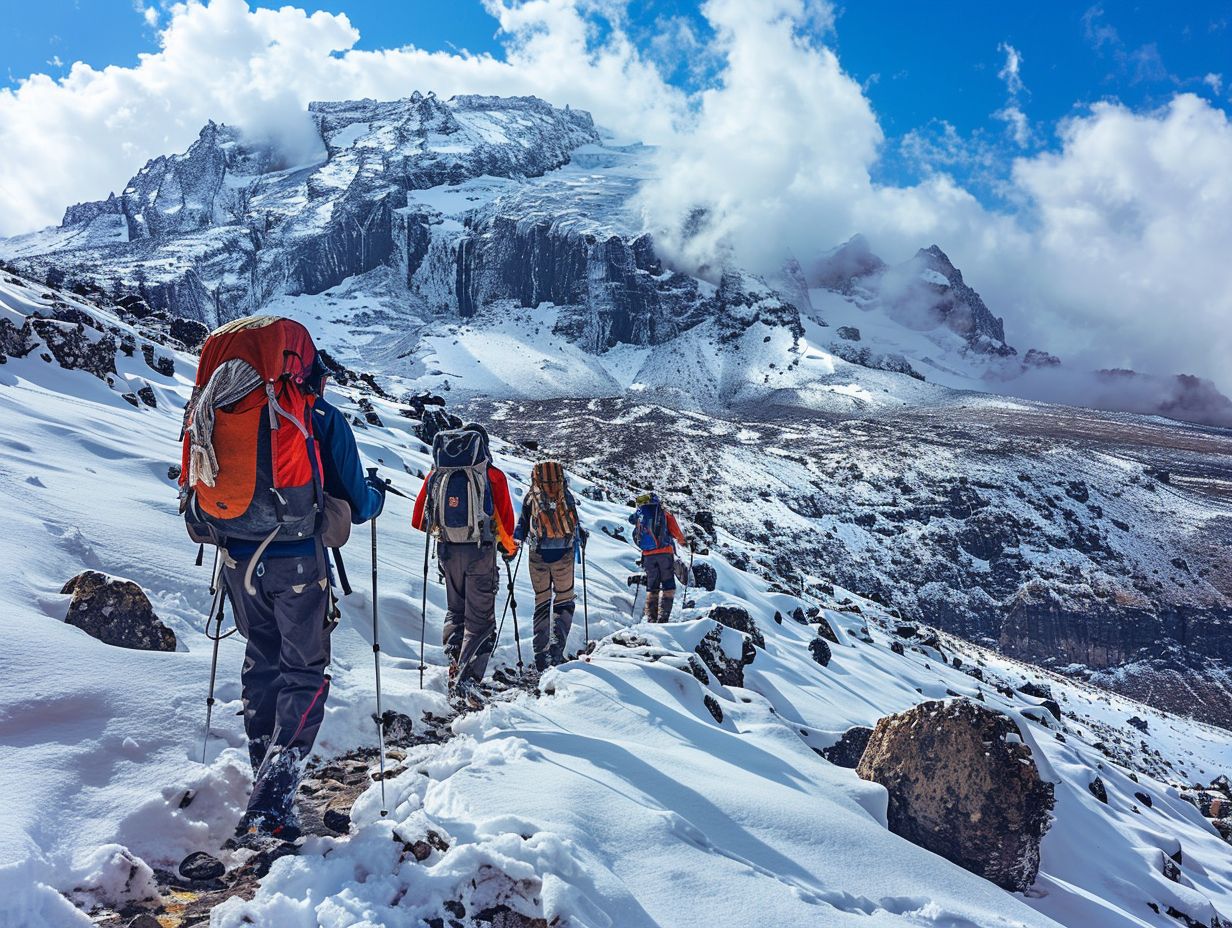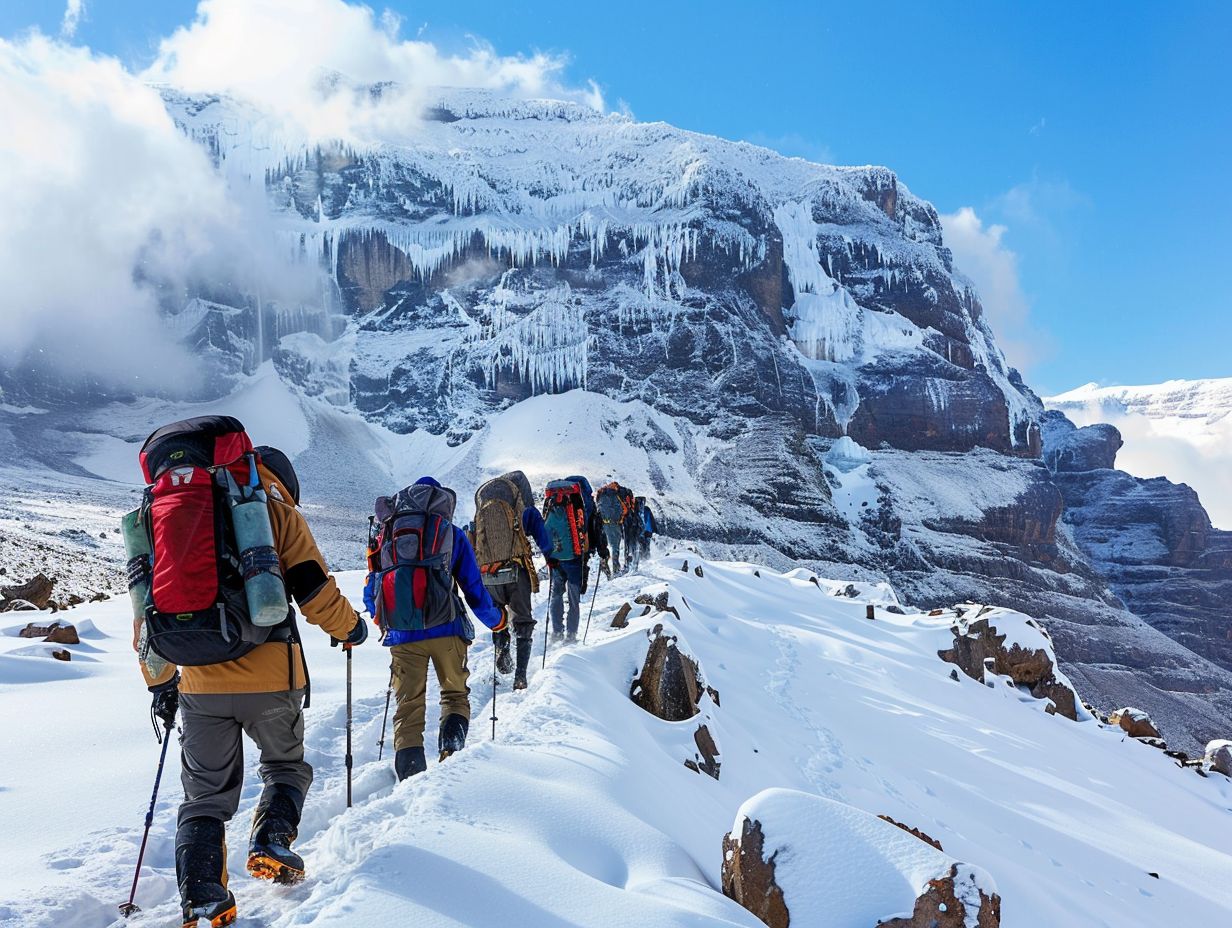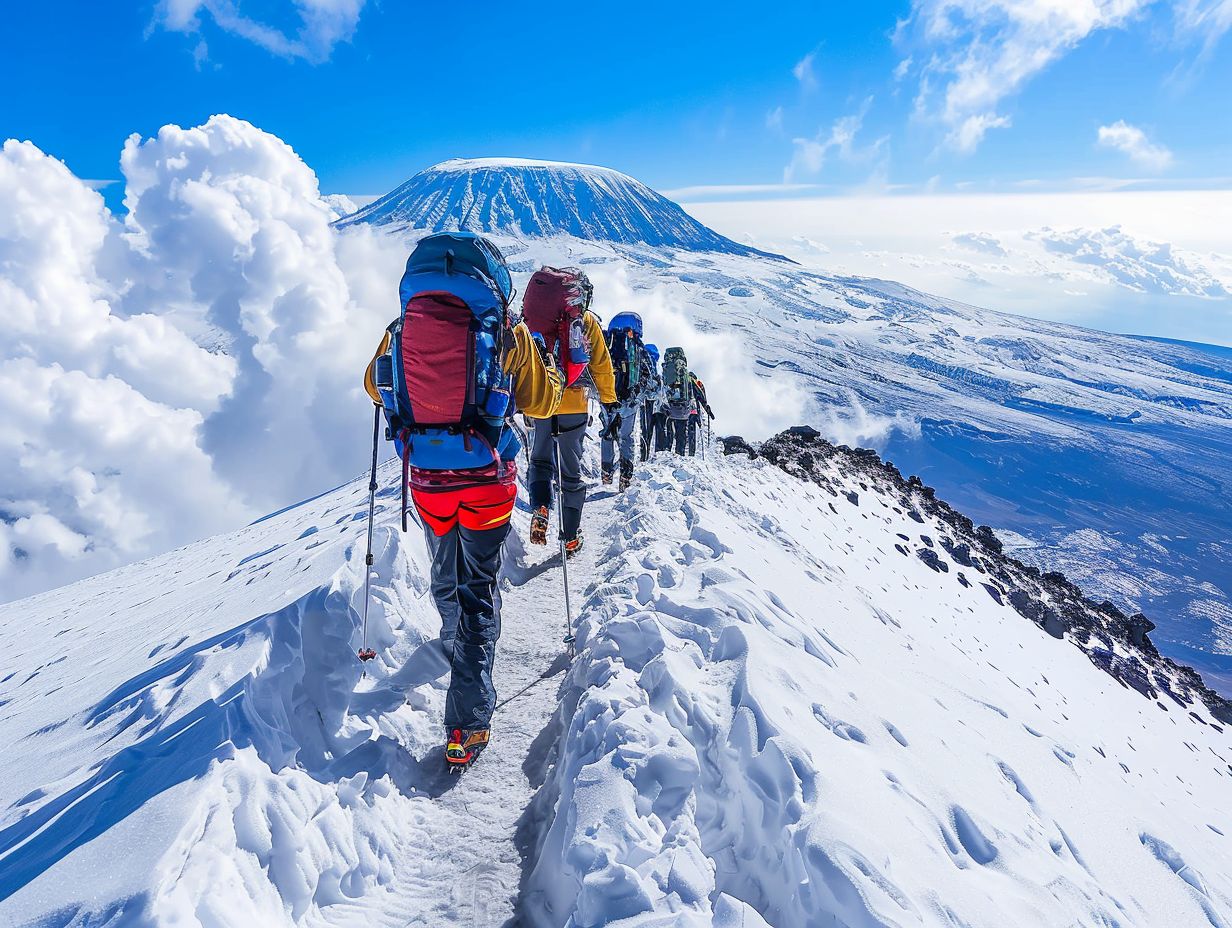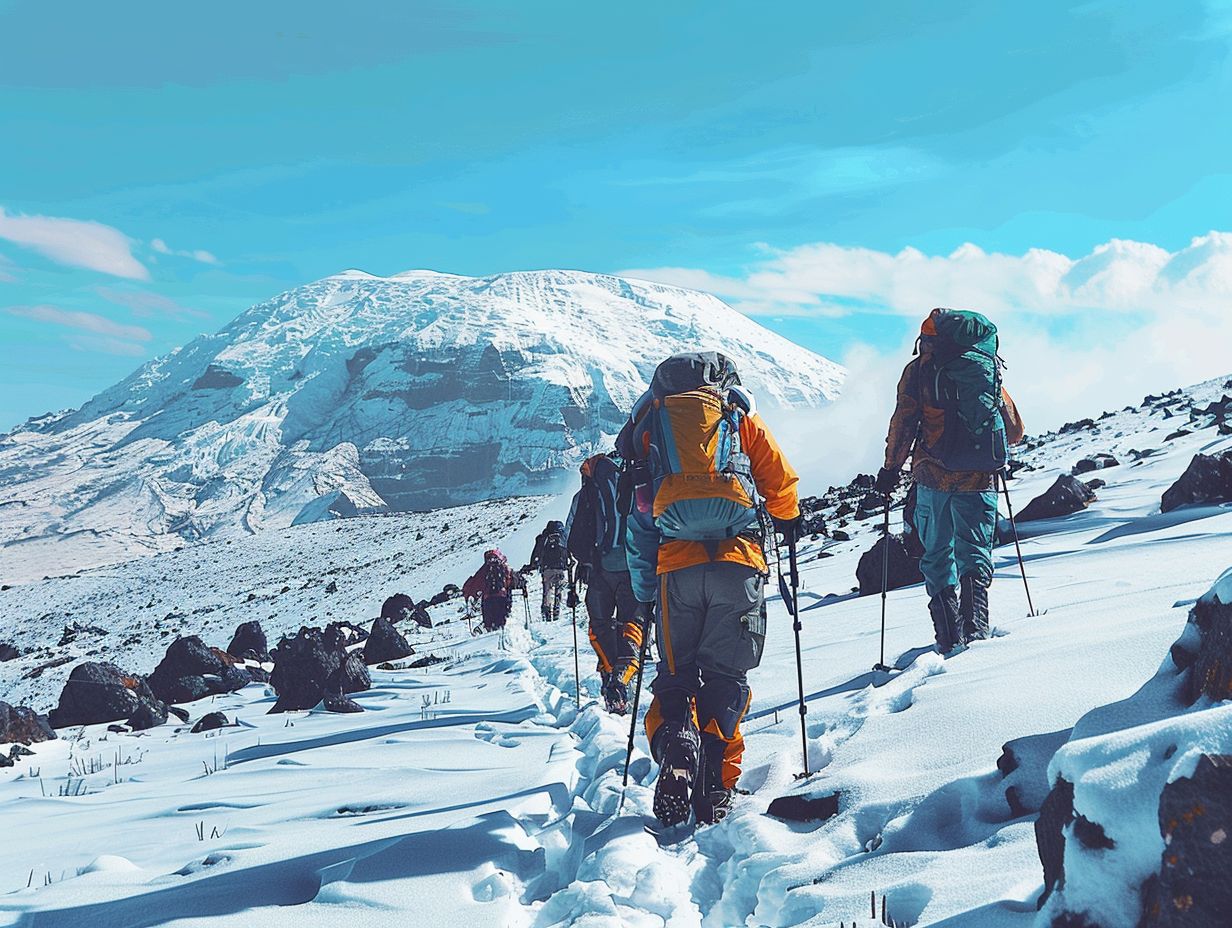
Climbing Kilimanjaro Cost
Have you ever wondered what it takes to climb Kilimanjaro?
From the personal achievement to the cultural experience and scenic views, there are countless reasons why people embark on this challenging journey.
But one question that often comes to mind is – how much does it cost to climb Kilimanjaro?
In this article, we will explore the various expenses involved, factors that affect the cost, and tips on how to save money while planning your climb.
So grab a cup of coffee and let’s dive into the world of Kilimanjaro expedition costs.
Key Takeaways:

- Climbing Kilimanjaro is a popular activity for personal achievement, cultural immersion, and breathtaking views.
- The cost of climbing Kilimanjaro varies based on permit fees, guide and porter fees, accommodation, food, gear, and travel expenses.
- To save money on climbing Kilimanjaro, consider joining a group climb, choosing a less popular route, bringing your own gear, traveling during the off-season, and negotiating with tour operators.
Why Do People Climb Kilimanjaro?
People climb Kilimanjaro for the unparalleled sense of personal achievement, cultural immersion in Tanzania’s diverse heritage, and the breathtaking panoramic views.
1. Personal Achievement
Embarking on a journey to conquer Kilimanjaro represents a significant personal achievement, pushing individuals beyond their limits and rewarding them.
Scaling the heights of this iconic peak is not just a physical feat but a mental and emotional triumph as well. The challenges faced on the mountain test one’s resilience, determination, and willpower.
As each step brings you closer to the summit, personal growth becomes intertwined with the physical ascent.
Emotions ranging from exhaustion to exhilaration accompany climbers as they navigate the rugged terrain and unpredictable weather conditions.
At every turn, climbers are faced with their inner strengths and weaknesses, confronting fears and doubts while embracing courage and perseverance.
The journey is as much about the mind as it is about the body. The sense of accomplishment felt at the peak is not just about conquering a mountain, but about conquering oneself.
2. Cultural Experience
Climbing Kilimanjaro offers a rich cultural experience as trekkers interact with local guides, porters, and communities, immersing themselves in the vibrant traditions and customs of Tanzania.
One of the unique aspects of embarking on a Kilimanjaro journey is the opportunity to engage with the diverse cultural tapestry that blankets the region.
Cultural immersion isn’t just limited to the climb itself; it extends to interactions with the local communities, where travelers can witness firsthand the daily lives, rituals, and celebrations.
From sharing meals with village elders to participating in traditional dances, every moment presents a chance to deepen one’s understanding of the rich heritage.
3. Scenic Views
The scenic views from Kilimanjaro’s summit offer a breathtaking panorama of the surrounding landscapes, including the vast expanse of the Kilimanjaro National Park and the stunning plains.
As you stand at the top, you are greeted with a mesmerizing sight of snow-capped peaks, lush greenery, and the vivid colors of diverse flora spread across the landscape.
The varying hues of the terrain, from rocky cliffs to rich forest canopies, create a true feast for the eyes. Bird’s eye views of the savannah below reveal herds of wildlife.
The picturesque sunsets and sunrises paint the sky in vibrant colors, reflecting off the vast plains and creating a serene and magical atmosphere.
How Much Does It Cost To Climb Kilimanjaro?
The cost of climbing Kilimanjaro varies depending on factors such as the chosen route, tour operator, duration of the climb, and the level of comfort and luxury desired by clients.
1. Permit Fees

Permit fees for climbing Kilimanjaro are essential costs that vary based on the chosen route and the regulations set by Kilimanjaro National Park authorities.
These fees play a crucial role in the overall cost of the trek, as they contribute significantly to the preservation and maintenance of the park’s ecosystem and facilities.
The pricing structures differ depending on the route, with some routes being more expensive due to the level of service and facilities provided.
These fees also help regulate the number of trekkers on the mountain at any given time, ensuring sustainable tourism practices and minimizing environmental impact.
2. Guide and Porter Fees
The fees for guides and porters on Kilimanjaro ensure the safety and well-being of clients, providing essential support throughout the trek and contributing to the overall success of the climb.
Guides play a crucial role in leading climbers through challenging terrains while sharing their local expertise and knowledge of the mountain.
They assess risks, monitor altitude sickness, and make vital decisions to ensure the group’s safety. On the other hand, porters carry heavy loads, set up camps, and assist with cooking.
Their hard work and dedication alleviate the burden on trekkers, making the journey more manageable and enjoyable.
3. Accommodation and Food
Accommodation and food expenses on Kilimanjaro vary depending on the chosen tour package, with options ranging from basic camping facilities to luxurious tented camps offering gourmet meals.
For those seeking a more immersive experience, the camping facilities provide a rugged yet authentic way to connect with nature during the climb.
These options are often equipped with essential amenities like sleeping bags and portable toilets. On the other hand, luxury tented camps cater to climbers looking for a touch of comfort.
In terms of sustenance, the significance of proper meal provisions cannot be overstated, particularly as climbers ascend to higher altitudes where appetite and digestive functions may be affected.
Most tour packages offer hearty meals packed with carbohydrates and proteins to fuel the strenuous trek. At higher camps, experienced cooks prepare nourishing dishes that help climbers acclimate.
4. Gear and Equipment
The cost of gear and equipment for climbing Kilimanjaro can vary based on the quality and type of items required, including essential clothing, footwear, trekking poles, and mountaineering gear.
Proper gear and equipment are crucial for a successful trek up Kilimanjaro, as they not only enhance safety but also contribute significantly to the overall experience.
Adequate clothing, such as moisture-wicking base layers, insulating mid-layers, and waterproof outer shells, ensures protection against unpredictable weather conditions.
Sturdy and well-fitted footwear with good ankle support is essential to navigate rugged terrain comfortably. Trekking poles assist in balance and reduce strain on joints.
Specialized mountaineering gear, including crampons and ice axes, may be required for certain routes and seasons. It’s advisable to invest in high-quality gear rather than compromising on safety.
While buying gear is a good long-term investment for avid climbers, rental options are available for those who prefer not to purchase all the equipment outright.
5. Travel Expenses
Travel expenses related to climbing Kilimanjaro include costs for flights, airport transfers, visa fees, and any pre or post-trek accommodations.
Travelers should keep in mind that direct flights to Kilimanjaro International Airport might be more expensive compared to landing in nearby airports and taking ground transportation.
Visa requirements vary depending on the traveler’s nationality, with many needing to obtain a visa upon arrival. In terms of accommodation, options range from basic camping to luxury lodges.
Ground transportation from the airport to the starting point of the climb also adds to the overall travel expenses.
What Are The Factors That Affect The Cost of Climbing Kilimanjaro?
Several factors influence the cost of climbing Kilimanjaro, including the choice of route, whether it’s a group or private climb, the season of the trek, the duration of the expedition, and any additional activities or services required by trekkers.
1. Route Choice
The choice of route on Kilimanjaro significantly affects the overall cost, as different paths offer varying levels of difficulty, scenic beauty, and amenities.
For example, the popular Marangu route, also known as the ‘Coca-Cola route’, is often favored for its relative ease and comfort, but tends to be busier and may lack the stunning views of other paths.
On the other hand, the Machame route is renowned for its breathtaking landscapes, including lush rainforests, challenging terrain, and an opportunity to acclimatize gradually.
Some routes like Lemosho or Rongai offer a more secluded and serene trekking experience, providing a greater sense of wilderness and tranquility.
2. Group or Private Climb

Opting for a group climb or a private expedition on Kilimanjaro can have cost implications, with group climbs offering shared resources and reduced per-person expenses.
Group climbs, organized by reputable operators, are often a popular choice for budget-conscious climbers seeking a more economical option.
Sharing costs for accommodations, meals, and equipment rental among a larger group can significantly reduce individual expenses, making it a cost-effective way to summit Kilimanjaro.
On the other hand, a private climb offers a more personalized and tailored experience, catering to the specific needs and preferences of the climbers.
This option allows for greater flexibility in determining the pace, itinerary, and level of support during the ascent.
3. Season
The season in which you choose to climb Kilimanjaro can impact the cost, with peak seasons typically commanding higher prices while off-peak periods may offer cost-saving opportunities.
In the peak season, which generally falls during the drier months from January to March and June to October, climbers can expect more stable weather and clearer skies, facilitating a smoother ascent.
The higher prices are often justified by the improved trail conditions and facilities like better-equipped campsites and experienced guides.
On the contrary, opting for the off-peak season, particularly during the rainy months of November and April, can lead to more economical expedition costs and fewer crowds on the trails.
Trekkers must be prepared for the wetter weather conditions, which can make the climb more challenging and less predictable.
4. Duration of Climb
The duration of the climbing expedition on Kilimanjaro directly influences the overall cost, with longer treks typically requiring additional logistical support.
When embarking on a longer climb, factors such as the number of days on the mountain play a crucial role in determining the budget.
Extended treks necessitate more camping gear, food supplies, and porters to carry the extra load, adding to the financial outlay of the expedition.
The duration affects the level of guide assistance needed, as prolonged journeys demand seasoned guides to ensure safety and navigation amid the changing terrain.
The logistical complexity of sustaining a team through an extended climb translates into increased costs associated with permits, accommodation, and staff wages.
Hence, while the allure of an extended Kilimanjaro trek offers a deeper adventure experience, it also comes with a higher price tag to cover the comprehensive support services.
5. Additional Activities
Participating in supplementary activities such as wildlife safaris, cultural tours, or acclimatization hikes before or after the Kilimanjaro climb can add to the overall cost.
Engaging in these additional activities not only broadens the scope of your journey but also deepens your connection with the diverse landscapes and cultures surrounding Mount Kilimanjaro.
Adventure packages and side tours provide opportunities to witness the stunning wildlife of Tanzania’s national parks or immerse yourself in the vibrant local traditions.
These experiences go beyond the physical challenge of the climb and offer a holistic understanding of the region, making your expedition more fulfilling and memorable.
How Can One Save Money On Climbing Kilimanjaro?
Saving money on climbing Kilimanjaro is possible by opting for a group climb, selecting a less popular route, bringing your own gear, choosing off-season travel dates, and negotiating cost-effective packages with tour operators.
1. Join a Group Climb
Participating in a group climb on Kilimanjaro can lead to cost savings through shared resources, communal arrangements, and group discounts offered by tour operators.
Being part of a group climb not only eases the burden on individual budgets but also fosters a strong sense of camaraderie among climbers.
The group dynamics create a supportive environment where members motivate and help each other throughout the journey, enhancing the overall experience.
Sharing the adventure with like-minded individuals brings a social element to the trek, enabling participants to form lasting friendships and share unforgettable moments together.
These factors make group climbs an attractive option for those seeking affordability, companionship, and shared memories on their Kilimanjaro expedition.
2. Choose a Less Popular Route
Opting for a less popular route on Kilimanjaro can offer financial savings as these paths may have lower permit fees, reduced accommodation costs, and fewer crowds.
Choosing a less traversed trail allows trekkers to immerse themselves in the raw beauty of the mountain without the distractions of large groups, fostering a greater sense of connection with nature.
Admittedly, these routes may demand more independence and self-sufficiency, making the adventure even more thrilling for those seeking a challenge.
From a logistical standpoint, the infrastructure on the less popular paths might be more basic, requiring careful planning and organization to ensure a smooth and safe trek.
The rewards of exploring these off-the-beaten-track options, such as discovering hidden gems and encountering authentic local culture, often outweigh the additional logistical considerations.
3. Bring Your Own Gear

Bringing your own gear for the Kilimanjaro expedition can result in cost savings as it eliminates rental fees, ensures familiarity and comfort with personal equipment, and allows for tailored packing.
Investing in high-quality gear that suits your specific needs means that you won’t have to compromise on comfort or performance during your ascent.
By having reliable equipment that you trust, you can focus on the stunning views and the incredible experience rather than worrying about the condition or fit of borrowed items.
Considering the rigors of a Kilimanjaro trek, having gear that you know well can significantly enhance your overall safety and enjoyment of the journey.
4. Travel During the Off-Season
Opting for off-season travel to Kilimanjaro can lead to cost reductions due to lower demand, discounted rates on accommodations and services, and the opportunity to experience the mountain.
Embarking on the climb during the off-season provides favorable weather conditions, with potentially clearer skies and more stable temperatures, enhancing the overall trekking experience.
Off-season climbing also allows climbers to enjoy a more peaceful journey, connecting with nature and the surroundings in a serene and undisturbed manner.
During quieter periods, adventurers have the advantage of more personalized attention from guides and support staff, ensuring a more tailored and intimate expedition.
Taking advantage of promotions and special offers available during the off-season further sweetens the deal, making off-season treks economically advantageous and highly rewarding.
5. Negotiate with Tour Operators
Engaging in negotiations with tour operators for Kilimanjaro expeditions can lead to customized packages, discounted rates, added value services, and flexible payment options.
Collaborating with experienced tour operators allows climbers to benefit from their knowledge of the region, ensuring a safe and well-organized trek up Kilimanjaro.
By discussing the itinerary, accommodation options, and logistical details, trekkers can make informed decisions and feel confident about their expedition.
Through negotiation, travelers can request specific services such as porter assistance, gear rental, or dietary accommodations, creating a more personalized and hassle-free climbing experience.
This open dialogue fosters a sense of partnership between the climbers and the tour operators, fostering a positive and rewarding adventure up Africa’s highest peak.
Frequently Asked Questions
1. What is the average cost of climbing Kilimanjaro?
A: The average cost of climbing Kilimanjaro can range from $1,500 to $4,000 depending on the route, number of days, and operator. This cost typically includes park fees, guides, porters, food, and accommodation.
2. What factors can affect the cost of climbing Kilimanjaro?
A: The cost of climbing Kilimanjaro can be affected by various factors such as the route chosen, the number of days, the time of year, and the operator. Additionally, personal gear and travel expenses may also contribute to the overall cost.
3. Are there any hidden costs when climbing Kilimanjaro?
A: Most reputable operators will include all necessary costs in their package price, but it is important to clarify with them beforehand to avoid any surprises. Some additional costs to consider may include tips for guides and porters, equipment rental, and extra snacks or drinks on the mountain.
4. Is it possible to climb Kilimanjaro on a budget?
A: While the cost of climbing Kilimanjaro can add up, it is possible to do it on a budget. Choosing a less popular route, joining a group climb, and bringing your own gear can help reduce costs. However, it is important to prioritize safety and not compromise on essential aspects of the climb for the sake of saving money.
5. Do I need to pay for a permit to climb Kilimanjaro?
A: Yes, all climbers are required to obtain a permit to climb Kilimanjaro. The cost of this permit is included in the overall cost of the climb and is typically taken care of by the operator.
6. Can I negotiate the cost of climbing Kilimanjaro?
A: While it may be tempting to negotiate the cost with operators, it is important to remember that a cheaper price may come at the expense of safety and quality. It is best to choose a reputable operator with a fair and transparent pricing system rather than trying to negotiate a lower cost.